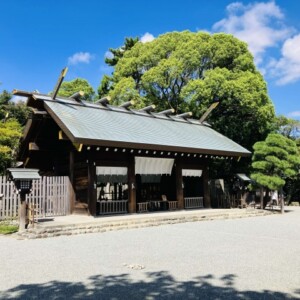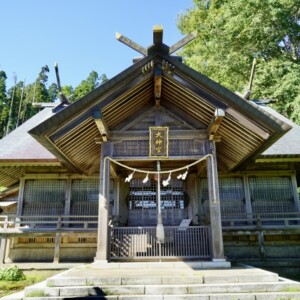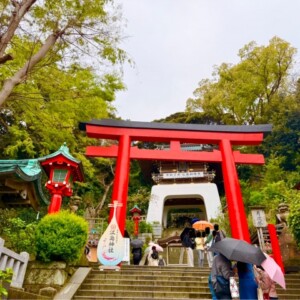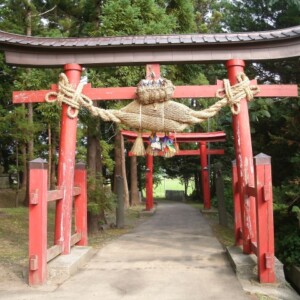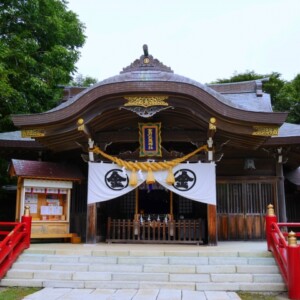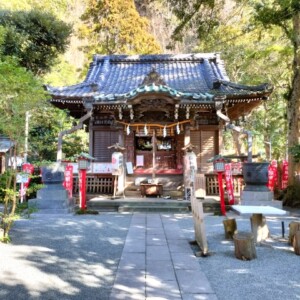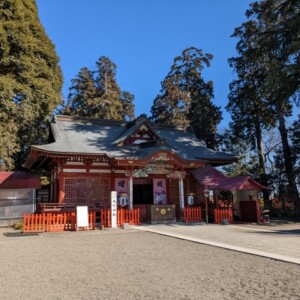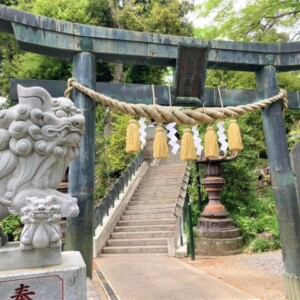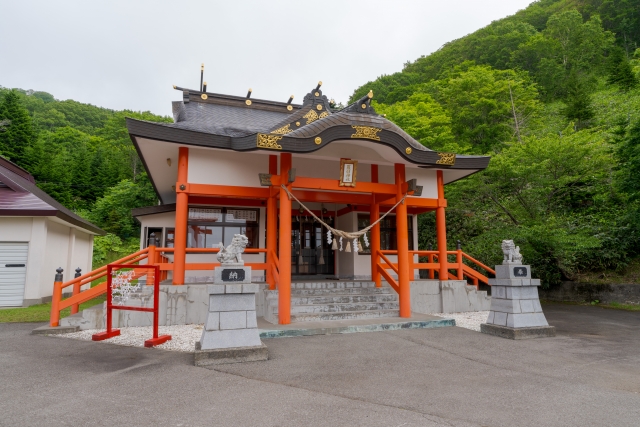
Rausu Shrine|A complete guide to the history, highlights, and worship information for the shrine that protects Shiretoko as its chief guardian.
Rausu Shrine, located in the town of Rausu on the Shiretoko Peninsula, a World Natural Heritage Site, is a historic shrine built at the end of the Edo period (1603-1868) to pray for safe navigation and the prosperity of the fishing grounds. As the general guardian of Shiretoko, it continues to watch over the town of Rausu and is loved by the local people. The shrine grounds also contain Rausu Gongensui, a clear spring water from the Mt. Rausu mountain range, which soothes the souls of worshippers.
Overview and basic information about Rausu Shrine
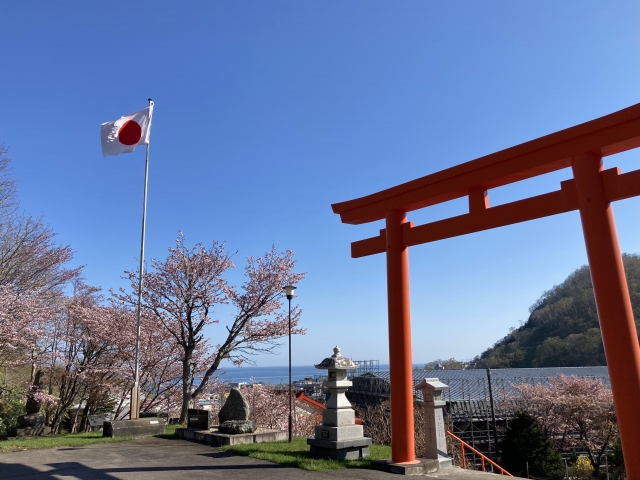
Rausu Shrine is located at 127-1 Sakae-cho, Rausu-cho, Menashi-gun, Hokkaido, and its annual festival is held on July 2. The shrine was founded in the Ansei Era (1615-1868), when the Matsumae Domain developed the Menashi fishing grounds as a contracted fishing ground, and built a small shrine on the hillside of Funami-machi to worship the spirit of Mt.
History and Origin
During the Meiji period (1868-1912), the number of residents increased so dramatically that a village was formed, and it was decided to relocate the shrine to a better location. After that, the shrine was rebuilt in 1914, 1934, and 1975.
On August 3, 1957, the religious corporation Rausu Shrine was established, and it continues to play an important role as the center of faith in the region. The name “Rausu” is said to be a corruption of the Ainu word “La-usi” (where the bones of the beast are), and derives from the fact that the Ainu people hunted in this area.
Gods and Benefits
The four deities of Rausu Shrine are Okuninushi no Mikoto, Emperor Sutoku, Kotoshironushi no Kami, and Rausudake Sanrei.
Okuninushi no Mikoto is also known as the main deity of Izumo-taisha Shrine, and is widely worshipped as the god of land development, agriculture, commerce, and medicine. He is believed to bring good luck in marriage, family happiness, and business prosperity. Emperor Shotoku is known as the god of learning, and Kotoshironushi is believed to be the patron god of commerce and fishing. In particular, Rausudake-sanrei, the mountain deity of Mt. Rausudake, the sacred mountain of the area, is worshipped by local people for safety of navigation and prosperity of the fishing industry.
Rausu Shrine Highlights and Features
The Rausu Shrine is built in the Gongen-zukuri style, with a shrine hall area of 59 tsubo (194.7 m2) and precinct area of 3,394.1 tsubo (11,200.6 m2). Surrounded by the rich natural environment of Shiretoko, the temple grounds offer beautiful scenery throughout the four seasons, providing visitors with tranquility and peace of mind.
Architectural and Structural Attractions
The pillars are made of a 500-year-old yew tree, a valuable building material that evokes the history of the area and the bounty of nature. The Gongen-zukuri shrine pavilions are built in the traditional shrine architectural style with the main hall and worship hall connected by a stone room, giving the pavilions a prestigious appearance.
Both the torii gate and the shrine building are new and beautiful, and visitors have commented that the azaleas blooming on both sides of the stairs leading to the torii are very beautiful and the well-maintained and beautiful shrine grounds are impressive. A monument to the ruins of the old main building stands in the precincts of the shrine. In commemoration of the 50th anniversary of the corporation, a stone monument was erected on the ruins of the main building of Rausu Shrine (1895 – 1914).
Nature and scenic beauty
From Rausu Shrine, located on top of a little hill as the general guardian of Shiretoko, you can see the town of Rausu and the Nemuro Straits. With the majestic mountains of the Shiretoko mountain range in the background, it is a perfect location from which to view Kunashiri Island, weather permitting.
The shrine is located in the midst of nature, and episodes of Ezo sika deer sometimes visiting the shrine are testimony to the rich natural environment of Shiretoko. In spring, azaleas bloom beautifully, and in autumn, the shrine grounds are decorated with autumn leaves, welcoming visitors.
Rausu Gongen Water
One of the main attractions of Rausu Shrine is that there is a place on the grounds where you can enjoy spring water from the Rausu Mountains called Rausu Gongen Sui (Rausu Gongen Water). The road to the left of the shrine building leads down to a spring called Rausu Gongen Sui, which is drinkable, and some visitors have reported that it is quite tasty.
This spring water is pure water that flows from Mt. Rausu and has been enjoyed by the local people for many years. It is a sacred water that should be tasted when visiting the shrine.
Guide to Worship and Visiting
Rausu Shrine can be visited throughout the year, and although there is no time limit, it is generally recommended to visit during the daytime. The shrine is well known to local people as the general guardian of Shiretoko, and has an open atmosphere that tourists can easily drop by.
Worship Etiquette and Manners
When visiting shrines, bow before passing through the torii gate and walk down the path, avoiding the center of the path. After purifying your hands and mouth at the handbasin, go to the hall of worship and worship in the manner of ni-worship, two beats, one hand. Rausu Shrine attracts many worshippers, especially those wishing for safe voyages, prosperity in the fishing industry, family happiness, and prosperous business.
In the shrine grounds, which are rich in nature, you may encounter wild animals such as Ezo sika deer, but please do not feed them or approach them, and watch them quietly. Also, when receiving Rausu Gongen Water, it is important to treat it with care and gratitude.
Annual Events and Regular Festivals
The Rausu Shrine’s annual festival is held on July 2 every year, and in a town with many fishermen, it has become a well-established Rausu festival with many Ujiko (shrine parishioners). During the festival, you can see brave young men carrying portable shrines in procession, and the women’s club of each neighborhood association performs service activities.
The annual festival is an important annual event in Rausu, and is open to both local residents and tourists. During the festival, the shrine grounds become especially lively, and it is an important opportunity to deepen the bonds of the community.
Red Seal Information
Red seals are available at Rausu Shrine from 07:00 to 19:00. They are always available, and many people receive red seals as a souvenir of their visit to the shrine. The red seals are treasured as proof of your visit to the shrine and also serve as a memento of your trip.
When receiving red seals, visitors can either bring their own red seal book or purchase one at the shrine. A carefully written red seal will be a special part of your experience at Rausu Shrine.
Access/Use Information
Rausu Shrine is located within easy walking distance of the Rausu town center, and can be visited as part of a walking tour of the town. It is an important stopover during Shiretoko sightseeing tours, and is popular with many tourists.
Access
To get to Rausu Shrine, take the Akan Bus from Kushiro Station to the Rausu Yakuba-mae stop via Nakashibetsu Town, or from Teshikaga Station to the Rausu Yakuba-mae stop via Nakashibetsu Town. It is within walking distance from the bus stop.
By air, the nearest airport is Nakashibetsu Airport, with flights from Haneda, Chitose, and Sapporo. From Nakashibetsu Airport, it is about a 70-minute drive. It takes about 5 hours and 30 minutes from Sapporo and about 3 hours from Kushiro by car.
Within Rausu Town, the Rausu Kokuho-Hospital-mae bus stop is a 3-minute walk away, and can be visited in conjunction with other sightseeing spots in the town. It is located at the end of a narrow alley that is difficult to find without a navigation system, so it is recommended that you check the location beforehand.
<Address> 127-1 Sakae-cho, Rausu-cho, Menashi-gun, Hokkaido, 086-1823 Japan
Hours, fees, and parking information
Rausu Shrine is open for worship 24 hours a day, but red seal service is available from 07:00 to 19:00. There is no admission fee, and anyone is free to visit the shrine. The shrine grounds are open and quiet, with only a sparse number of individual tourists coming to visit.
Parking is limited, so it is recommended that you check with the shrine beforehand. Since Rausu is a relatively compact town, it is possible to use other parking lots in town and walk to the shrine.
During the winter months, the Shiretoko Crossing Road is closed to traffic, so access may be limited. It is important to check road conditions and traffic information before visiting.
Reference sites
Rausu-cho Official Tourist Information Website: https://kanko.rausu-town.jp/spots/view/15
Hokkaido Shrine Office: https://hokkaidojinjacho.jp/羅臼神社/



